Welcome to the vibrant and diverse world of Shetland Sheepdog colors!
These adorable pups are known for their stunning beauty and striking patterns. And yes they come in a wide array of coat colors that captivate the hearts of dog lovers everywhere!
Ready to explore them all? Let’s go!
6 Standard Shetland Sheepdog Colors
Have you been wondering ”What are the colors of the Sheltie AKC?”
Well, if you take a look at their official breed standard, you will find out that the American Kennel Club (AKC) recognizes 6 of standard colors that define the Sheltie’s iconic look.
Here are the colors that not only look pawesome, but will allow your dog to participate in the show ring!
1. Sable & White
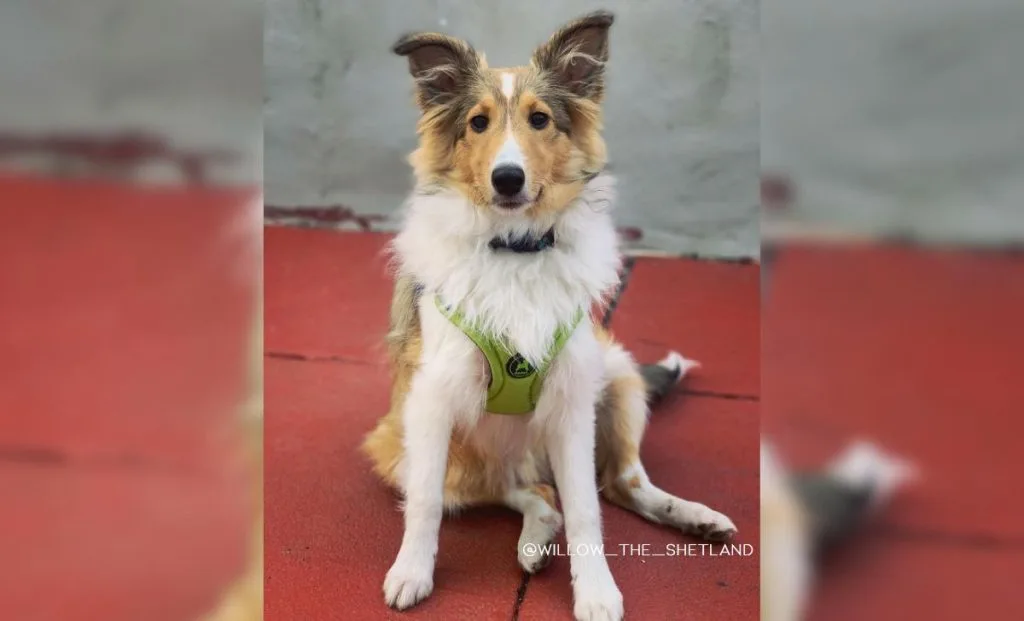
Let’s start off with the Sable & White Shetland Sheepdog, that is truly a sight to behold. This pup inherits a beautiful blend of rich, golden-brown fur with contrasting white markings.
This coloration is also found in other breeds like Collies, German Shepherds, and some Spaniels.
Their double coats, often described as harsh hair, are both dense and luxurious. These Shelties frequently appear in the show ring.
Can you imagine their adult coat gleaming under the lights? So adorable and elegant!
2. Black White & Tan

Moving on to the Black White & Tan Sheltie.
This canine sports a striking and sophisticated tri-color coat that immediately catches the eye.
This color pattern includes a glossy black base, white markings, and rich tan points.
The black coat provides a perfect backdrop for the head markings and other distinct Sheltie colors. Tri-color Shelties may inherit blue eyes due to their genetic makeup.
Such a color pattern is also seen in breeds like Bernese Mountain Dogs and Australian Shepherds.
3. Blue Merle White & Tan

The Blue Merle White & Tan Sheltie is perhaps one of the most enchanting color variations within this dog breed.
This mesmerizing coat features a mix of different colors including black, white, blue-gray patches, and tan points.
Their darker fur patches provide a striking contrast against the lighter areas.
The merle gene responsible for this pattern creates a marbled effect which gives each Sheltie a one-of-a-kind appearance.
The blue merle Shelties often have stunning blue eyes or even light blue eyes!
4. Blue Merle & White
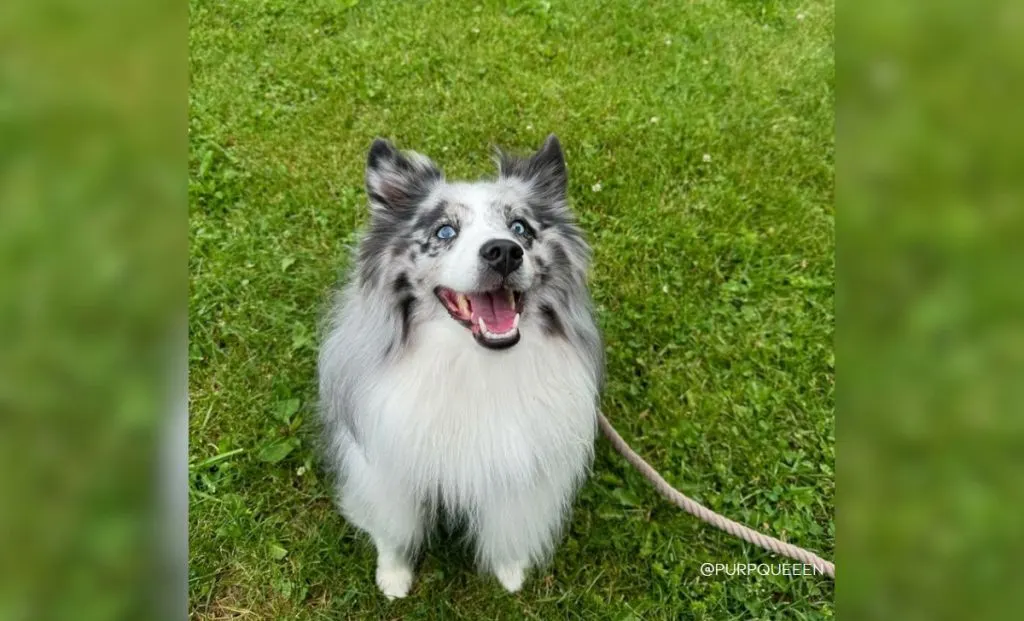
Is this Sheltie blue? Hmm, maybe gray? Well, the Blue Merle & White Shetland Sheepdog is truly a fascinating mix of different colors!
Apart from having their chest look as if it was dipped in white paint, these pups boast various shades from light to dark blue-gray, often accented by a white coat. All of this is a result of a merle gene.
This gene creates a stunning merle pattern, giving Sheltie’s coat a marbled or speckled appearance.
The blue merle Shelties are known for their captivating blue eyes or light blue eyes, which add an extra layer of mystique to their appearance.
In addition to their mesmerizing coat, these Shelties often have distinctive head markings and patches of darker fur.
Blue merles are not exclusive to Shelties! This beautiful pattern can also be found in other dog breeds like Australian Shepherds, Border Collies, and Catahoula Leopard Dogs.
The double merles can sometimes result in more extensive white areas, due to aforementioned white factoring.
An interesting study shows that the prevalence of deafness in merle dogs is significant, with 4.6% being unilaterally deaf and another 4.6% bilaterally deaf. Double merles are more likely to be deaf than single merles (1).
5. Black & White
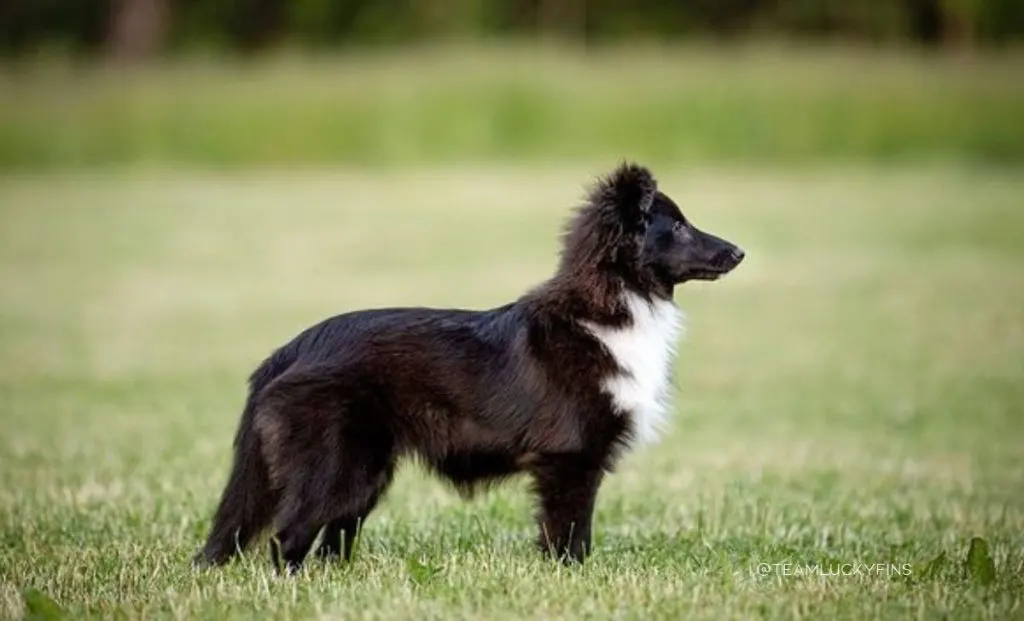
The Black & White coloration in Shelties results from specific gene interactions and color modifications, rather than the merle gene or double merles seen in other color patterns like blue merles or blue merle white.
The base coat color is relatively straightforward, but the interplay of black and white makes each Sheltie dog unique.
The Black & White Shetland Sheepdog, as shown in the picture, is truly an example of a timeless and striking color combination that never goes out of style.
The black fur covers the majority of the Sheltie’s body, including the back, sides, and part of the face, creating a bold and elegant appearance.
Contrasting the deep black, the Sheltie has a clean white coat in specific areas.
The white fur prominently appears on the chest, extending upwards to the neck, creating a majestic collar-like effect.
This white colour also marks the lower parts of the legs, paws, and the tip of the tail, and provides a big contrast against the darker fur.
Black & White Shelties often have tan points on the eyebrows, cheeks, shoulders, and butt.
The Sheltie’s face, particularly around the muzzle and sometimes above the eyes, also features white markings and/or a white blaze that enhance its expressive head colour.
Here’s a fun fact for you. Coat color influences the length of stay (LOS) and likelihood of adoption in shelter dogs. Black dogs tend to have the longest LOS, while brindle and multicolor dogs are adopted more quickly (2).
Other dog breeds that exhibit similar black & white color patterns include Border Collies, Boston Terriers, and some Spaniels.
6. Sable Merle & White

The Sable Merle & White Sheltie is a visually striking dog that combines several colors in a unique and beautiful pattern.
The base color of a Sable Merle & White Sheltie is typically a rich golden sable.
Interspersed with the sable base are patches of diluted colors due to the merle gene.
Significant areas of white are common in this color pattern. The white coat areas are typically found on the chest, legs, and sometimes the face.
This color is influenced by the agouti gene, specifically the a^y allele, which produces the sable coloration.
The gene controls the distribution of the sable coloration. The dominant a^y allele leads to the sable expression, where the fur has banded colors, giving the golden to reddish-brown hues seen in mahogany sable Shelties.
The addition of the merle gene (M) introduces patches of diluted color, resulting in areas of blue-gray or lighter shades within the sable coat.
8 Non-Standard Shetland Sheepdog Colors
These Shetland Sheepdog colors are not typically recognized in the conformation show ring, but they are still beautiful and occur naturally within the breed.
Let’s check ’em out!
1. White Black & Tan

This color pattern is similar to the traditional tri-color but with more white.
The black and tan markings are present but overlaid on a predominantly white coat. This combination creates a striking contrast.
2. White & Black
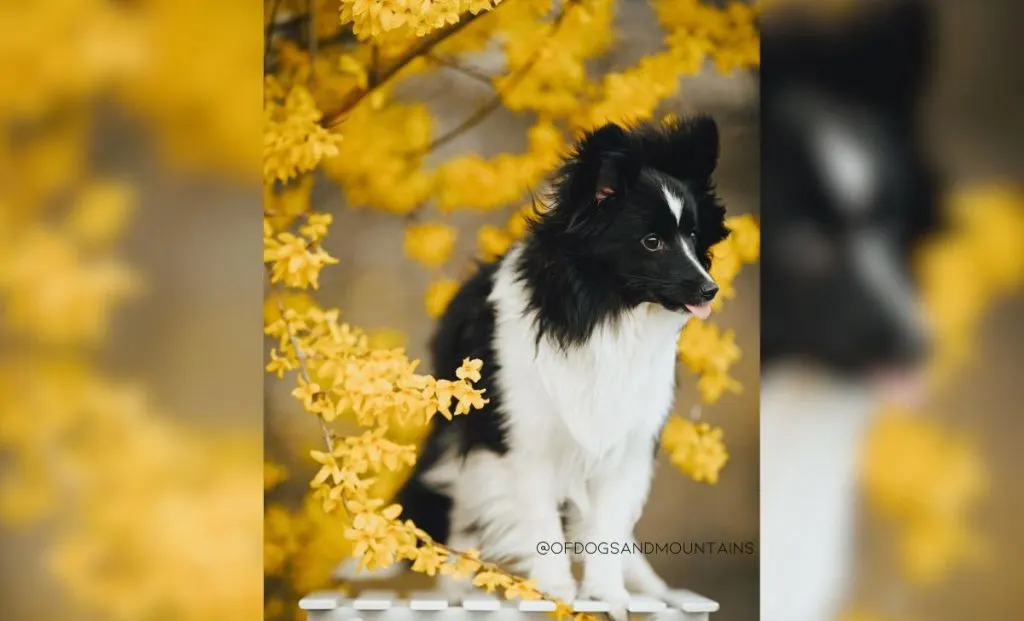
Similar to the Bi-Black pattern (that we will get to later) but with more extensive white areas.
These Shelties have a mostly white coat with black patches, which is quite a rare sight to behold!
3. White & Sable
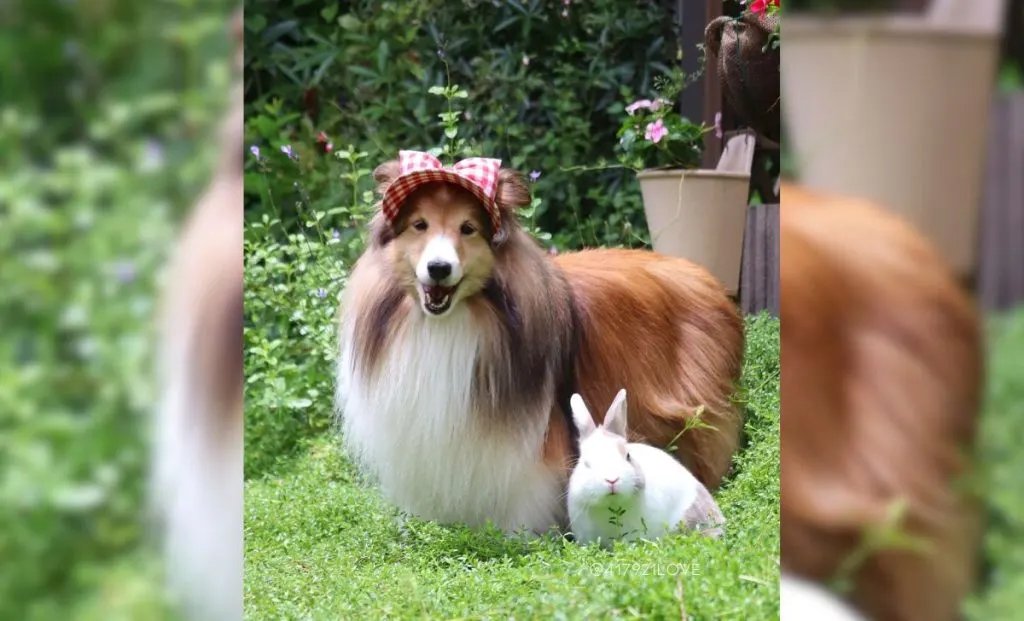
Similar to the white and black, these Shelties feature mostly a white coat, but with patches of sable.
4. White
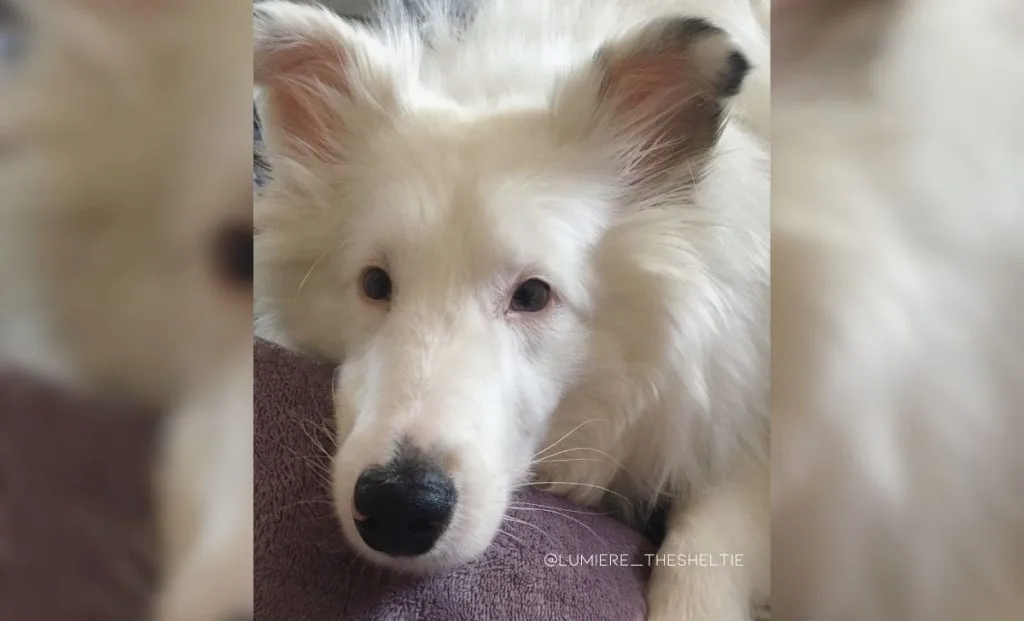
A predominantly white Sheltie is quite rare and often results from significant expression of piebald or extreme white spotting genes.
These Shelties have a pure and serene look, with minimal other coloring.
They may resemble one of the teddy bear-like dog breeds such as the Great Pyrenees and Samoyeds.
5. White Blue Merle & Tan

This pattern features a predominantly white coat with patches of blue merle and tan.
The combination of blue-gray merle patches with tan points and white results in a uniquely beautiful and eye-catching appearance.
6. White Blue Merle
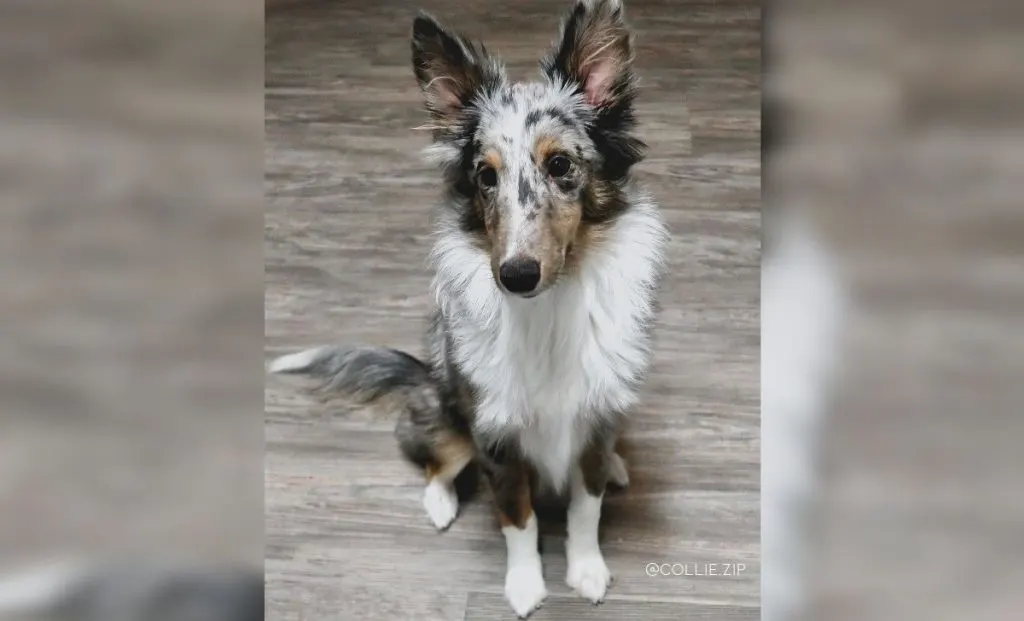
Similar to the White Blue Merle & Tan but without the tan points. The coat is mostly white with blue merle patches, making for a beautiful and distinctive look.
7. White & Sable Merle
Again, this is a rare color combination that features a predominantly white coat with patches of sable merle.
The mix of golden sable and blue-gray merle on a white background is truly unique and eye-catching.
8. Black & Tan
This color pattern resembles the classic Doberman or Rottweiler coloration.
These Shelties have a black base coat with distinct tan markings on the face, chest, and legs.
What Is The Rarest Color For A Sheltie?
What a load of nice Shetland Sheepdog colors! There is a huge range of variations, each more beautiful than the last.
Among these, some Sheltie colors are particularly rare and sought after by enthusiasts and breeders alike.
I must point out though, that these are not standard coat colors of this dog breed. Therefore, these rare pups are not allowed to compete in AKC shows.
But that doesn’t mean that they are not the cutest! Let’s see, shall we?
1. Bi-Black
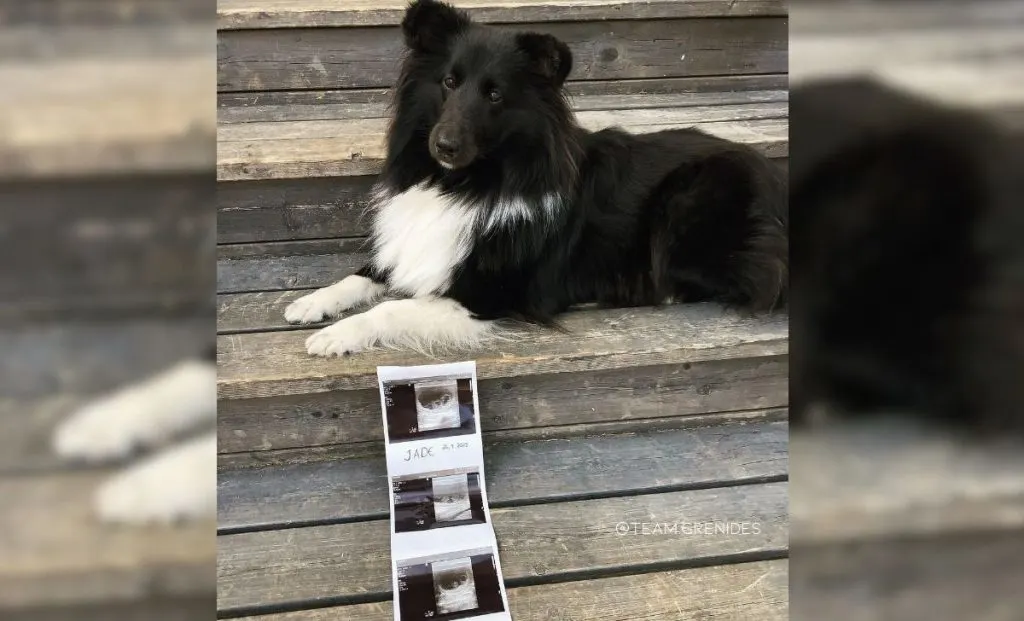
A Bi-Black Sheltie features a black coat with white markings, but without the tan points seen in tri-color Shelties.
The absence of tan makes the coat pattern simpler and more monochromatic. The term “bi” indicates two colors: black and white.
Now, you may be wondering, what’s the difference between a Bi-Black Sheltie and a Black & White Sheltie?
Bi-Black Shelties only have black and white colors, whereas Black & White Shelties can be tri-colored, featuring black and white with additional tan points on the eyebrows, cheeks, shoulders, and butt.
The gene interactions involved here do not include the alleles responsible for tan fur, resulting in a two-color combination of black and white.
So, unlike the tri color shelties, Bi-Black Shelties lack the tan points, making their appearance more monochromatic and bold.
Bi-Black Shelties can remind you of a classic tuxedo, always looking sharp and sophisticated.
2. Bi-Blue
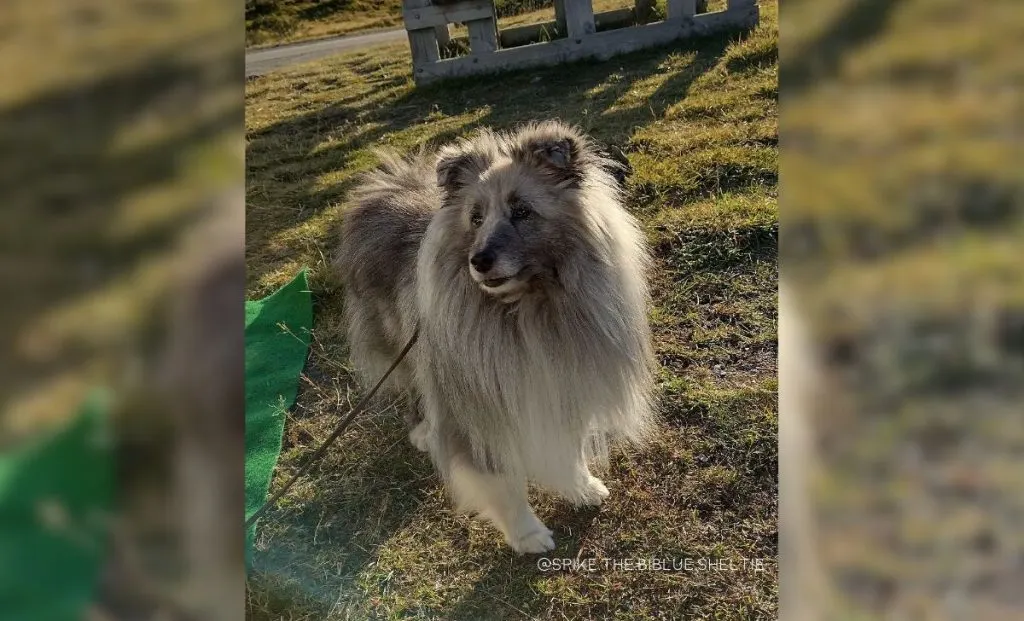
A Bi-Blue Sheltie has a coat that combines blue merle (a mottled or patchy combination of black, gray, and white) with white, but lacks the tan points found in traditional blue merle Shelties.
The term “bi” again means two, indicating that the dog has two primary colors: blue merle and white.
This pattern is created by the interaction of the merle gene with the blue merle sheltie’s coat, diluting the black fur to shades of blue-gray while preserving the white markings.
This color is very rare and is often shown in Shetland Sheepdog cross breeds that have either two or both parents with merle genes.
3. Double Dilute
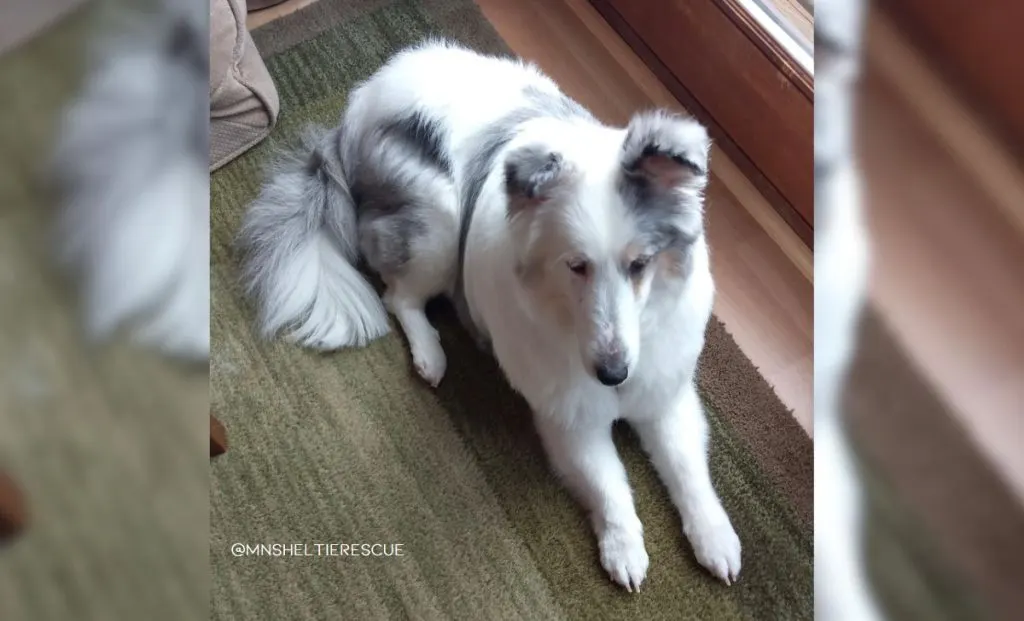
A Double Dilute Sheltie, also known as a Double Merle or Homozygous Merle, is a result of breeding two merle-patterned dogs together.
This genetic pairing produces a puppy with two copies of the merle gene (MM).
The presence of two copies of the merle gene (MM) leads to significant color modifications in the dog’s coat, usually diluting the base colors extensively.
This genetic combination can affect the head markings and lead to unique various shades in the coat.
Double Dilute Shelties typically have predominantly white coats with faint patches of their base color.
Breeding two blue merle shelties (or any merle-patterned dogs) can produce these double merles, often referred to as double dilutes.
This practice is generally discouraged due to the high risk of health problems, such as deafness and blindness due to the absence of pigment cells (3).
4. Color-Headed White
A Color-Headed White (CHW) Sheltie is a unique and striking variation of the Shetland Sheepdog characterized by a predominantly white body with colored markings primarily on the head and sometimes on parts of the body.
The head retains the typical Sheltie colors, such as sable, black, or blue merle, giving the dog its name. This contrast between the head and body makes CHW Shelties particularly eye-catching.
The Color-Headed White pattern is due to the inheritance of white factor genes from both parents. These genes, which are a form of the piebald spotting gene, cause a significant increase in the white areas of the dog’s coat.
So, when two Shelties carrying these genes are bred together, their puppies can inherit this trait, leading to the Color-Headed White pattern.
The body of a Color-Headed White Sheltie is mostly white, sometimes with small patches of color on the back or near the tail.
5. Sable Merle

Among all the Shetland Sheepdog colors, the Sable Merle Sheltie is a fascinating and somewhat controversial variation.
This color results from the interaction of the merle gene with the sable coat, creating a blend of sable and merle patterns that can be quite striking.
The Sable Merle Sheltie has a golden sable base coat that is interspersed with patches of merle, resulting in a marbled effect. This can include various shades of gold, brown, and blue-gray.
Identifying a Sable Merle can be tricky for an untrained eye, especially as the dog matures.
As puppies, the merle pattern is usually more visible, but it can become less distinct as they grow. This can lead to misidentification and potential breeding complications if a Sable Merle is mistakenly thought to be a pure sable.
To avoid such issues, breeders and owners are encouraged to use genetic testing to confirm the presence of the merle gene.
References
1. Strain, G., Clark, L., Wahl, J., Turner, A., & Murphy, K. (2009). Prevalence of deafness in dogs heterozygous or homozygous for the merle allele.. Journal of veterinary internal medicine, 23 2, 282-6 . https://doi.org/10.1111/j.1939-1676.2008.0257.x.
2. Voslarova, Eva & Zak, Jiri & Vecerek, Vladimir & Bedanova, Iveta. (2018). Coat Color of Shelter Dogs and Its Role in Dog Adoption. Society & Animals. 27. 10.1163/15685306-12341491.3. Strain, G. (2012). Canine deafness.. The Veterinary clinics of North America. Small animal practice, 42 6, 1209-24 . https://doi.org/10.1016/j.cvsm.2012.08.010.

Meet Iram, a devoted veterinarian, passionate dog lover, and current Ph.D. candidate at Utrecht University in the Netherlands. Seamlessly blending her roles as a vet and content writer, Iram channels her love for dogs into heartfelt narratives.
Since childhood, Iram nurtured a dream of becoming a vet, a passion that runs deep in her family. Having now fulfilled that dream, she’s eager to share her acquired knowledge. In her writing, Iram not only explores the emotional bond between humans and their canine friends but also integrates her veterinary expertise, offering readers a holistic understanding of their beloved pets.
